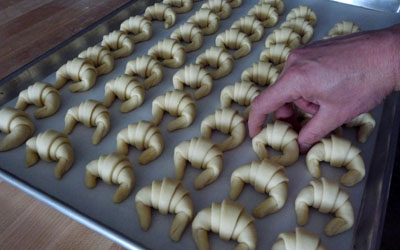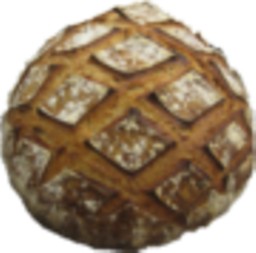Ultimamente le miche di grande pezzatura hanno trovato il mio favore. Un pane tondo, con farina semi-integrale ed impasto tenero, profilo "basso", ben cotto e lievitato naturalmente. In letteratura questo tipo di pane è spesso descritto come "il pane di una volta" tipicamente prodotto nei piccoli paesi o nelle cascine e cotto in forno a legna. In Francia potrebbe assomigliare a quello fatto nei primi del '900 a cui si è ispirato Poilane, in Italia al pane di Genzano/Lariano ed in Canada a quello riportato da James MacGuire come il tipico pane mangiato negli insediamenti europei.
Lately very large miches found my favor. A large round bread, with sifted whole wheat flour, "low" profile, well cooked and naturally raised. In literature this type of bread is often described as "the old style bread" typically produced in small villages or farms and cooked in wood fired oven. In France it might look like the one baked in the first years of '900 that inspired the famous Pain Poilane, in Italy to the bread of Genzano /Lariano and in Canada to that one reported by James MacGuire as the type of bread typically eaten by the early European settlers.

Le persone un pò più anziane lo descrivono così e ne ricordano nostalgicamente i sapori ed i profumi. Purtroppo non ho mai avuto il piacere di parlare con qualcuno che ricordi veramente com'era quel pane e che riesca in modo razionale a confrontarlo con quello attuale. Le persone hanno ricordi che definirei romantici o di vita quotidiana come, ad esempio, "era molto buono e profumato", "durava più di una settimana", ... provo spesso a fare domande semplici ma più precise - "dove prendevano la farina?", "usavano il lievito madre?", "come conservavano il lievito?", "come impastavano?", "che consistenza aveva la mollica?" - ma il più delle volte ottengo risposte molto vaghe.
The elderly describe it like this and they remember the flavors and aromas with nostalgia. Unfortunately I never had the pleasure of speaking with someone who really remember how it was, I mean in a rational way to be able to compare that bread to the current one. People have memories that I define romantic or daily life as, for example, "it was very good and fragrant", "it lasted more than a week", ... often I try with more precise but simple questions - "where did you buy the flour?", "did you bake with sourdough?", "how did you store the yeast?", "what about the kneading?", "what was the consistency of the crumb?" - but most times I get very vague answers.
I nomi utilizzati per questo tipo di pane sono tanti: micone, pane di campagna, pane paesano ..., ma il pane è sempre quello.
The names used for this type of bread are many: large miche, country bread, rustuc bread ... but the bread is always the same.
Mia madre mi racconta di quando era piccola e viveva in Sicilia. Avevano una piccola attività commerciale e suo padre faceva il pane in un grande forno a legna per poi venderlo in paese. Era il "pane di una volta", molto probabilmente con le stesse caratteristiche che ho descritto, ma prodotto con farina di grano duro siciliano. Nella "casa del forno", così la chiamavano, si svolgeva la panificazione. C'era una stanza adibita alla preparazione ed un'altra per il forno. In questi locali venivano ospitati anche dei piccoli pulcini che avevano bisogno di stare al caldo (... le norme sanitarie non esistevano). Usavano il "criscenti" (crescente in italiano) ovvero del lievito madre asciutto, nient'altro che un pezzo di impasto (una pagnotta) riportata da un impasto al successivo; nessuna indicazione sulla sua conservazione.
My mother tells me when she was young and she lived in Sicily. They had a small business, his father baked in a large wood fired oven and he sold the bread in town. It was the "old style bread", most likely with the same characteristics I have described, but produced with durum wheat grown in Sicily. In the "house of the oven", it took place the baking process. There was a room used for preparation and another for the oven. In these room were also hosted small chicks who needed to warm temperature of these rooms (... no health rules, I think). They used the "criscenti" ("crescente" in Italian, it means something that rise, very close to the French word "levain") a stiff sourdough, just a piece of dough preserved day by day, I have no indication of its conservation.
Ma com'era veramente "il pane di una volta"? Probabilmente non era esattamente quello che ricordano queste persone. La memoria del gusto è a mio parere qualcosa di molto complicato e facilmente influenzabile: avete presente come sembra buona una pietanza quando si ha molta fame mentre lo è molto meno se siamo sazi? E poi il gusto cambia e può accadere che venga influenzato, anche negativamente, dai nuovi cibi. Non è difficile trovare persone ormai assuefatte da quel pane bianco, borbido e senza crosta o dal classico francesino di gomma che fanno i nostri panettieri milanesi?
But was it really "the old style bread" we are thinking about? Probably it was not exactly what these people remember. In my opinion the memory of taste is something very complicated and easily influenced by many factors: you know how everything looks good when you are very hungry but it is much less if you are full? Moreover the taste changes over the time and it can happen to be influenced by the new bad foods. It is not difficult to find people now addicted to that soft white bread without crust.
Fatto stà che la mia ricerca continua e per ora mi accontento di questo:
The fact is that my research continues and for now I'll settle with this:

Utilizzo farina di tipo 1 (buratto) e due lieviti liquidi su differenti farine. Questa volta ho fatto due pagnotte una con lievito su buratto + lievito su segale e l'altra con lievito su buratto + lievito su enkir. La pezzatura è di 1.4Kg di impasto e la pagnotta prodotta ha un diametro di 25-30 cm, la massima portata della mia pietra refrattaria e del mio forno elettrico!
I use italian type 1 flour and two liquid levain on different flours. This time I baked two loaves one with a wheat levain + rye levain and the other with wheat levain + enkir levain. The dough weighs 1.4Kg and the baked miche has a diameter of 25-30 cm, the maximum capacity of my stone and my oven!


Lavorare in ciotola con questo impasto è molto bello soprattutto grazie alla consistenza morbida della pasta (idratazione del 75%). Non tutti riescono a gestire correttamente questo tipo di pasta. Bisogna essere gentili e non stressare il glutine, il modo migliore è utilizzare un impastamento breve e delle piegature. Anche la formatura può risultare un pò difficoltosa vista la consistenza e il peso dei pezzi, mano decisa ma leggera. Poi non parliamo dell'infornamento, sono costretto ad estrarre dal forno la pietra refrattaria su cui ribaldo la pagnotta, in questa fase il margine d'errore è minimo e basta poco che combinare un disastro.
Working in a bowl with this dough is very nice especially with the soft texture of the dough (about 75% hydration). You should be gentle and do not stress the gluten network, the best way is to use a short kneading and folding. Even the shaping can be a little difficult given the texture and the weight of the pieces, firm but gentle handling. Then the baking, I have to take out of the oven the hot baking stone and flip over the loaf, at this stage the range of error is minimal and it is really easy to make a mess.
Se l'impasto è condotto bene la mollica dovrebbe essere perfettamente fermentata:
If the dough was well treated the crumb should be perfectly fermented:

Visto che ho parlato di pane paesano, cascine e forni a legna, forse è il caso di concludere rivelandovi cos'è quella struttura in mattoni che si intravede dietro la mia foto personale: il forno di Cascina Croce, un piccolo paese a due passi da casa mia, restaurato nel 2001 da ItaliaNostra sezione Milano NordOvest. Sicuramente, un giorno vi racconterò qualcosa di più su questo forno ...
Since I spoke of country miche, farms and wood fired ovens, perhaps it is appropriate to conclude revailing what is the brick structure that can be glimpsed behind my personal picture: the wood fired oven of Cascina Croce, a small town not far from my house, it was restored in 2001 by ItaliaNostra Milano NordOvest section. Surely, one day I will tell you more about this oven ...



Giovanni











 taping
taping the loft
the loft bamboo floor
bamboo floor mini croissants
mini croissants mini croissants baked
mini croissants baked hot cross buns
hot cross buns burger buns
burger buns



